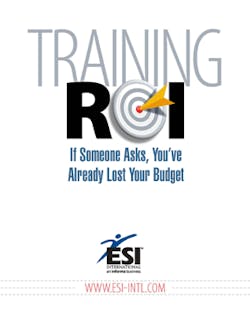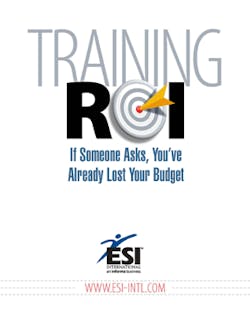Are You Getting a Good Return on Investment for Your Training Efforts?
The recently released ESI International report, “Training ROI: If Someone Asks, You’ve Already Lost Your Budget,” shows how businesses finally can measure what they’re getting for their training dollars. Here are the top three misconceptions of calculating ROI, according to ESI:
1. I don’t need it; people Intuitively understand the value of our training programs.
Generally, people do understand that learning programs bring value to the organization, but that’s not the issue. The issue is how much value? Remember, your noble mandate to transform the organization does not exist in a vacuum. To some degree, everyone in the organization shares the same mandate.
Somewhere on someone’s desk sits a portfolio of organizational initiatives, which is continuously being evaluated and prioritized. Your programs are somewhere on that list, and whether you realize it or not your training budget is being discussed, challenged, and in times like these, attacked in the never-ending fight for resources. Your challenge is to fight your way to the top of the list, and ROI is your best weapon.
2. If someone wants to see ROI, they will ask for It.
If ROI is important, then why aren’t people asking for it? First, you need to understand that people are not looking for reasons to justify your programs. They are looking for reasons to cut them. It’s always true, but it is particularly true
in today’s environment. It is up to you to make your case; nobody else is going to do it for you.
Second, realize that in lean times leadership tends to shift toward the CFO’s office. CFOs tend to make data-driven decisions and ROI is their gold standard. If others are providing it and you are not, then your training program is going to feel very soft and squishy to them and your position in the portfolio of initiatives is likely to sink like a rock.
3. It is very difficult – if not impossible – to calculate.
Calculating a true ROI is difficult, particularly when the value of training is not conveniently quantifiable, and typically it is not. That’s okay, because you don’t need to calculate true ROI. You only need to prove beyond a reasonable doubt that your program is cost justified. For any analysis there is a “cost of capture” that must be more than offset by the value it brings.
In other words, it is not going to do you a lot of good to have guys in white lab coats and stop watches come in and spend half of next year’s training budget trying to justify how you’ve spent this year’s budget – the juice has got to be worth the squeeze. If it is too difficult and costly, you are doing it wrong.
Prove Your Learning Program Has Impact
If you can’t prove a return on your training program – real learning that is adopted and applied – then you run the risk of having it cut back or even losing it. You may think that measuring ROI is hard. However, if you follow these fast, hard rules provided by ESI International, you’ll be on your way to proving your learning program has measurable impact:
1. You don’t need to go overboard in calculating ROI. You only need to prove beyond a reasonable doubt that your program is cost-justified.
2. Shift your thinking from a quality mindset to an impact and results mindset. ROI is more than a calculation; it’s a way of thinking. Learning professionals often focus on the quality of their training rather than the impact of the learning, assuming that quality leads to learning and learning leads to impact. While quality is important, it doesn’t go far enough in proving that training positively impacts the business.
3. Calculate ROI continuously so you always know how much benefit your program is generating. There are two ways to waste training dollars – train people who don’t need it or train people who don’t use it. Neither of these things has to happen in your program if you have a handle on what is working and what is not.
4. Build your case for ROI step by step. Getting to ROI is like building a court case. You make arguments and then present facts to support them. Ultimately, these arguments and facts result in an obvious conclusion – that your training program generates more value than it costs.
5. The more data points you have, the better. The people who matter when it comes to making your case are typically analytical – COO and CFO types – and likely will want an explanation as to how you reached your conclusion. Validate your findings with as much data, from as many different perspectives, as possible. That means the trainees’ responses immediately after the course and a couple of months after, as well as their managers’ responses.
6. ROI isn’t just about money. Analyze results that lead to ROI across the following four levels of learning measurement: quality, effectiveness, job impact and business results.
7. Be as conservative as possible in your ROI calculations. Self-reported scores should be factored down to compensate for bias. Additionally, you should use the delivered job impact number reported in the follow-up survey rather than what was predicted immediately after the class. Often, students are very enthusiastic about the learning right after the completion of the course, which causes bias. The follow-up survey results allow for a more true measure.
8. Know the investment outlay. Since ROI by definition is a return on investment, it stands to reason that it can’t be calculated without knowing the investment itself. First, calculate the investment: class cost added to the salary of the learners for the days within class. Then, calculate the return: multiply the average salary by the percent students said their work improved due to training.
9. Communicate the story behind the numbers. When you’re discussing your program with stakeholders, clearly state the goals of your program as you first envisioned it, the challenges you faced and how you overcame them to make a difference for the business.
10. Don’t be discouraged by low ROI numbers. Low ROI can be improved. Taking a proactive stance and a comprehensive view of job support and other adoption practices will get your ROI numbers where they need to be and ensure the continuation and advancement of your learning programs.
About the Author

Sandy Smith
Sandy Smith is the former content director of EHS Today, and is currently the EHSQ content & community lead at Intelex Technologies Inc. She has written about occupational safety and health and environmental issues since 1990.

